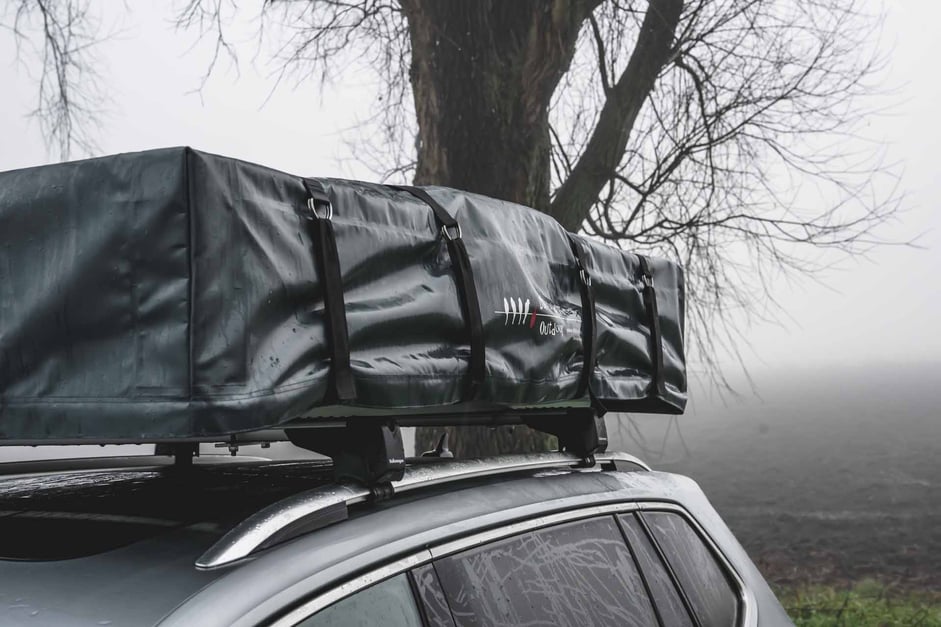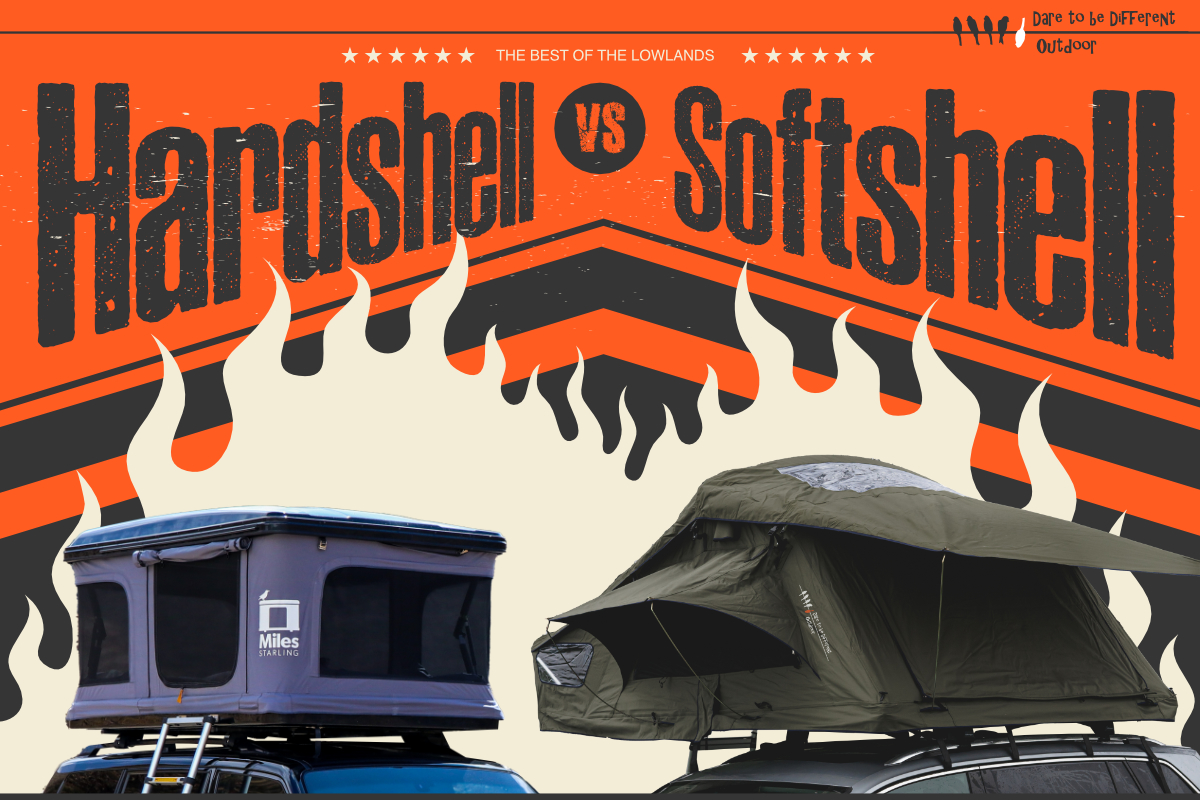Those who are getting their bearings in buying a rooftoptent soon find out that there are two choices in the rooftoptent world. Namely a hardshell or softshell rooftoptent. Both types of rooftoptents have their advantages and disadvantages. When choosing a rooftoptent that suits you best, there are several factors to consider. Consider weight, price, sleeping comfort and expansion options. But don't forget the speed at which you set up the rooftoptent, the storage/storage of a rooftop tent or the way you travel. Let's take a quick look at the differences between hardshell and softshell rooftoptents.
The Entrance
To get right to the point, or should we say rooftoptents? One of the biggest differences with the hardshell and softshell rooftoptents is the entrance and ladder. In all softshell rooftoptents, the ladder is mounted with a hinge point on the bottom plate, over the protruding part of the rooftoptent. With hardshell rooftoptents this is not always the case, many hardshell rooftoptents use a separate ladder, allowing you to use it in different places to enter the rooftoptent. A great advantage of this is that you can enter the rooftoptent anytime, anywhere, even if space for camping is limited. A disadvantage of this is that you always have to carry the ladder separately in the car or in the rooftoptent.
.jpg?width=902&height=601&name=DTBD-Femkesrooftoptents%20Miles%20Starling%20140x214%20Hardshell%20(12).jpg)
Weight
In general, softshell rooftoptents are a lot lighter than hardshell rooftoptents. This is a big advantage for smaller and compact cars. A softshell rooftoptent has a lower roof load which is especially important for vehicles with a lower carrying capacity. This makes it possible, for example, to attach another awning additionally to the roof racks.
Important tip: always include the weight of the roof racks in combination with your rooftoptent. The weight combined should not exceed the maximum roof load.

Price
Softshell rooftoptents are often slightly cheaper than hardshell rooftoptents. This can be an important factor if you are looking for an affordable option. For the price, a softshell rooftoptent often offers just a little more space and is more compact on the roof.
Bed length and sleeping comfort
One of the biggest differences between hardshell and softshell is the bed length and also the options for different bed widths. A softshell rooftoptent is often available from 140 cm wide to 220 cm wide with a length of 230 cm. A hardshell is often no wider than 140 cm with a length of 210 cm. This often means that with a height of 1.8m you can't lie stretched out in the rooftoptent with a pillow above your head. If you are a sleeper with one arm above the head and under the pillow, sufficient length does not hurt. And a Hardshell is soon too short.

Fuel consumption
The consumption of your car is an important factor to consider, a car with rooftoptents will always consume more than normal. Once is a fact. An assumption often made is that a hardshell is more economical than a softshell rooftoptent due to its dynamic shape. Something that is not quite correct, a hardshell rooftoptent is often heavier than a softshell rooftoptent. The weight difference between the two types of tents cancels out the aerodynamic advantage. It is also not the case that you may drive faster with a hardshell rooftoptent than with a softshell rooftoptent, for example. With both rooftoptents, the maximum speed does not exceed 130 km/h.
Camping space
A major advantage of the hardshell rooftoptent is that it requires a small area as camping space. With a softshell rooftoptent, part of it always folds out, so you need more space to set up the tent. This is not the case with a hardshell rooftoptent. You unfold the rooftoptent above the car, ladder next to it and that's it.
.jpg?width=890&height=593&name=DTBD-Femkesrooftoptents%20Miles%20Starling%20140x214%20Hardshell%20(17).jpg)
Climate in the rooftoptent
This factor is a bit more complicated to include than others, as it depends entirely on the design of the hardshell rooftoptents. When sufficient windows are included in the design, the following does not apply. Hardshell rooftoptents are made with aluminum base plate and roof or ABS base plate and roof, this gets hotter faster and does not ventilate. As a result, you are more likely to get a sweltering feeling inside the rooftoptent and it can feel stuffy. A Softshell rooftoptent is a full canvas product, except for the bottom plate. Because of this a softshell rooftoptent ventilates much better and also creates a pleasant climate inside the rooftoptent while sleeping.
Expansion possibilities
There are several expansion options for both types of tents. In some they are easier to use than in others. A softshell rooftoptent always has an overhang that can be used as an awning. Optionally, it is still possible to attach a side wall and stretch it as an awning or windbreak. The roof tent's overhang also makes it very easy to attach an awning for extra privacy and living space. Especially when it rains, an under-tent can be very useful, as it keeps you dry. With a hardshell rooftoptent you can also get awnings, these often have separate poles which makes them more difficult to set up and do not close off completely.
A big advantage of the hardshell rooftoptents is that there are possibilities to extend the rooftoptents with extra carriers on the roof. This allows you to attach an extra bike or surfboard to the roof if the roof load of the car is sufficient.
What is a big advantage of a softshell rooftoptent, due to its lower weight it is more often possible to attach another awning to the roof racks. In fact, with a softshell in combination with the roof racks, you don't just go over the maximum roof load of modern cars and often keep some extra for an awning. Because of the weight of a hardshell, with roof racks and rooftoptents you are often just under or at the maximum roof load.
Storage
Storing a rooftoptent always takes space, if you are lucky you might be able to use a system to hang the rooftoptent from the garage roof. However, many people do not have this luxury and have to put it away on the ground. Both a hardshell rooftoptent and softshell rooftoptent can be stored on the side. A big difference in this is that the softshell is compact to store and also because of its thickness, stays up by itself. A hardshell rooftoptent is much longer to put away. They often have a length of 215cm. On top of that, a hardshell rooftoptent cannot stand on its own and you have to take care not to damage the hard material.
Assembly and disassembly
One of the most important aspects of choosing a rooftoptent is how quickly you can set it up and take it down. It is often said that hardshell rooftoptents are faster to set up than softshell rooftoptents and there is some truth in that. We tested it for you some time ago and the difference is minimal, only 30 seconds. Don't believe it? Check out this video:
As you can see, the difference is minimal when assembling. It took only 3 minutes and 55 seconds for the hardshell, and 4 minutes and 24 seconds for the softshell. Taking down a softshell rooftoptent does take a little longer than a hardshell rooftoptent, here the difference is just over 1.5 minutes. With the hardshell it took 3 minutes and 40 seconds and the softshell took 5 minutes and 17 seconds. For the difference in speed you don't really have to do it.
Conclusion
Softshell and hardshell rooftoptents both have advantages and disadvantages. It mainly depends on the way you want to travel, if you choose for a softshell you will have the real tent feeling faster and this is therefore often seen as camping equipment. A hardshell rooftoptent is convenient because of its small footprint, you park your car somewhere, fold up or open the tent and you can sleep anywhere. Hardshell rooftoptents are more likely to be seen as a means of transit. Above all, look carefully at what suits you.
The pros and cons in brief:
Entrance: Hardshell has a separate ladder and you can enter through multiple sides, a softshell has 1 entrance and a fixed ladder at the bottom of the bottom plate.
Weight: Softshell rooftoptents are generally lighter in weight than hardshell rooftoptents, which makes it possible to bring an extra awning or look for a larger size, for example.
Price: Softshell rooftoptents tend to be slightly cheaper than hardshell rooftoptents.
Bed length and sleeping comfort: Hardshell rooftoptents are often no longer than 210cm, which often makes it difficult for people over 1.8m to lie flat. Also, it is not possible to get hardshell in different widths.
Fuel consumption: There is no difference here, a hardshell is aerodynamic but heavier than a softshell so the difference in consumption is nil.
Camping space: The biggest advantage of a hardshell is the footprint, as it is no larger than the car and does not fold out extra. Ideal for transit. A softshell rooftoptent always folds out extra so you need more space.
Climate inside the rooftop tent: A softshell rooftop tent is an all cloth product except for the bottom plate, therefore almost the entire rooftop tent is breathable. Hardshell is made of an ABS or aluminum base plate and roof, which heats up faster and ventilates less well.
Expandability: Hardshell rooftoptents often have a big advantage (not all models) it is possible to attach something else to the roof. This is not the case with softshell, although with softshell you can often attach an awning or other accessories more easily.
Storage: A hardshell is often more difficult to store, you need the entire length in space which is easily 210cm. You also need to make sure that you put everything away as well and as stable as possible. Without scratching the aluminum or ABS material. A Softshell rooftoptent is smaller to put away and stays well on its side, without extra support.
Assembly and disassembly: There is no difference between rooftoptents when assembling, only 30 seconds. The time for the hardshell is only 3 minutes and 55 seconds, for the softshell 4 minutes and 24 seconds, breaking down the difference in speed is greater, a softshell takes 1 minute longer to fold. With the hardshell it took 3 minutes and 40 seconds and the softshell 5 minutes and 17 seconds.
*Side note: here we are comparing hardshell rooftoptents with softshell rooftoptents and thus are not talking about so-called hybrid rooftoptents.






